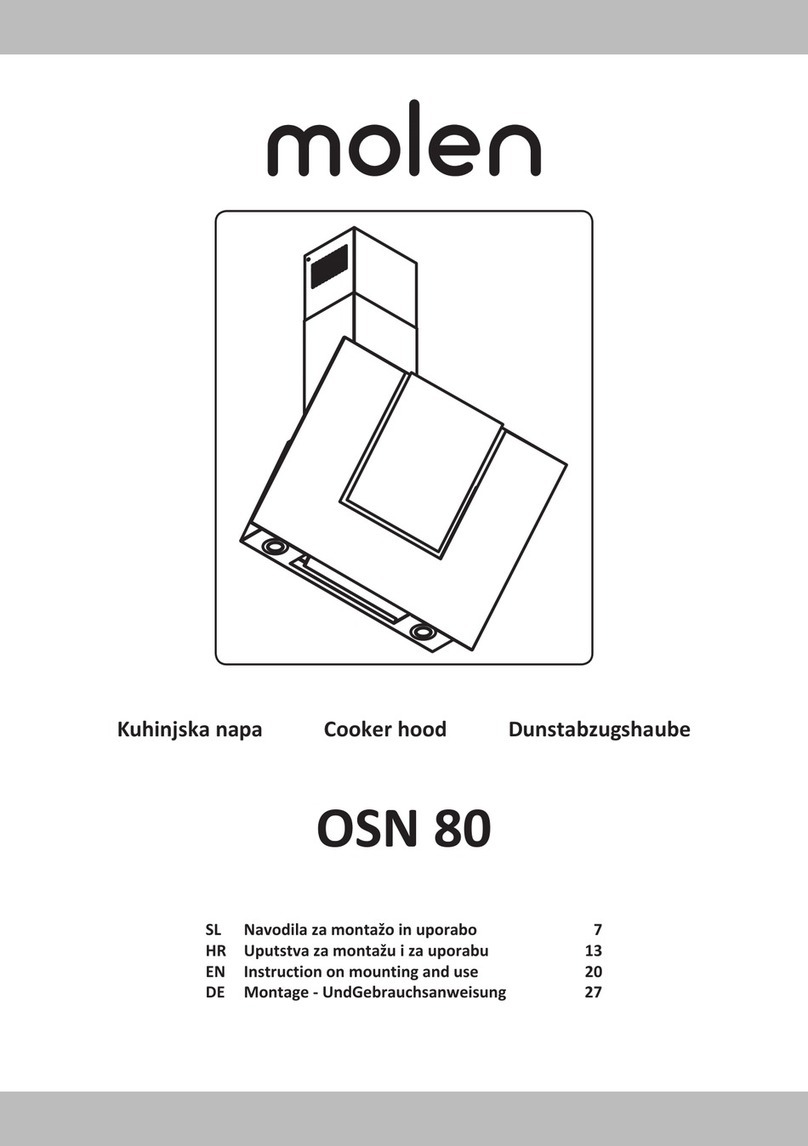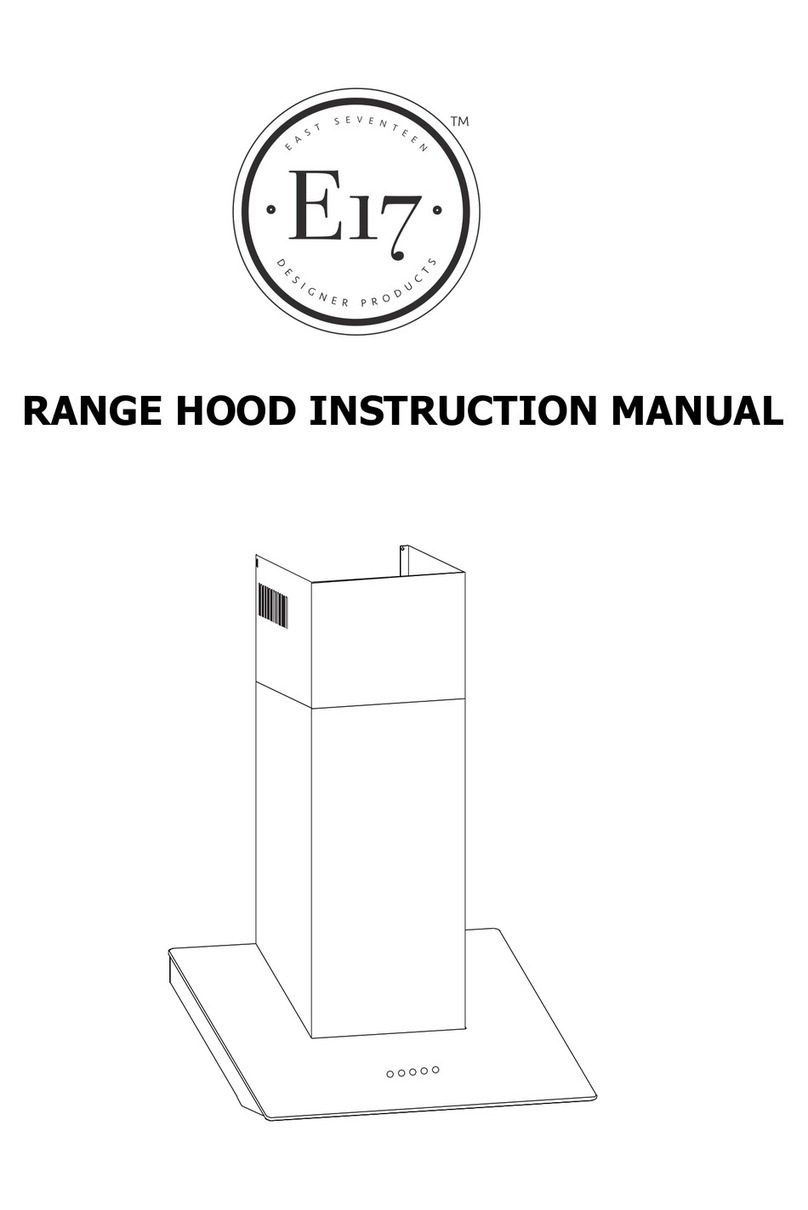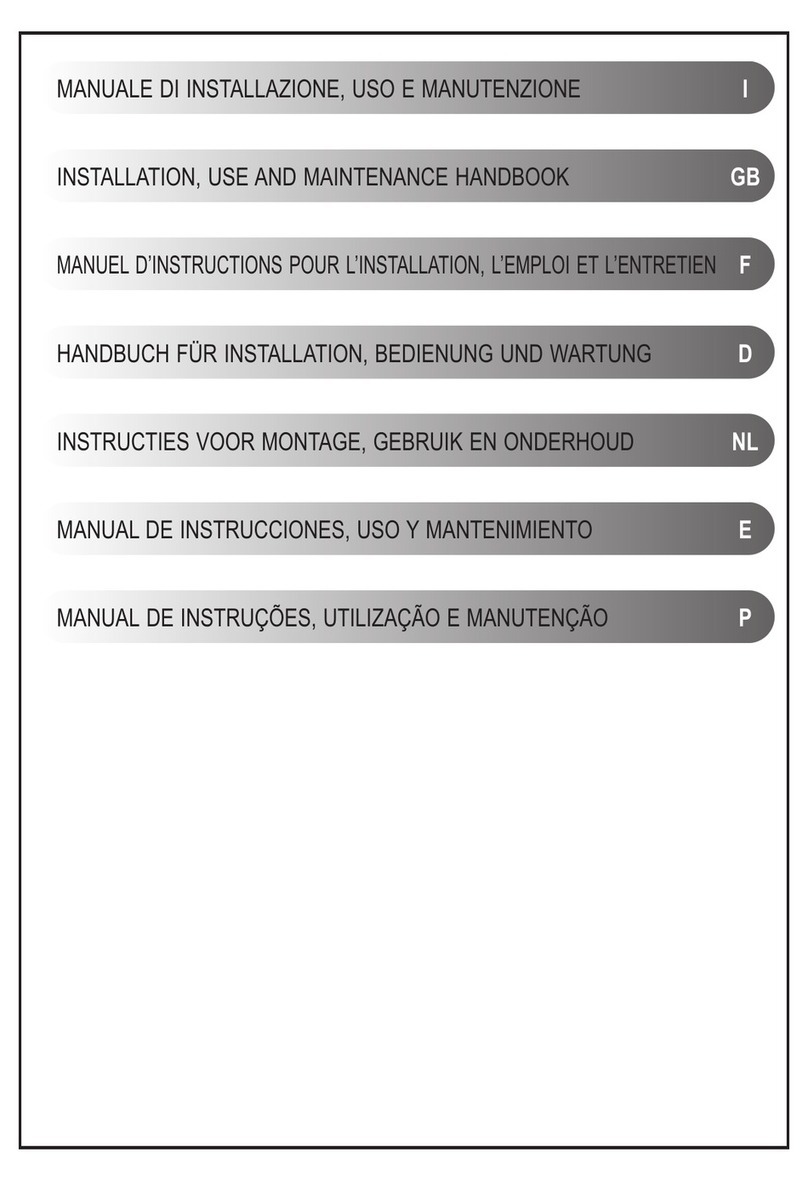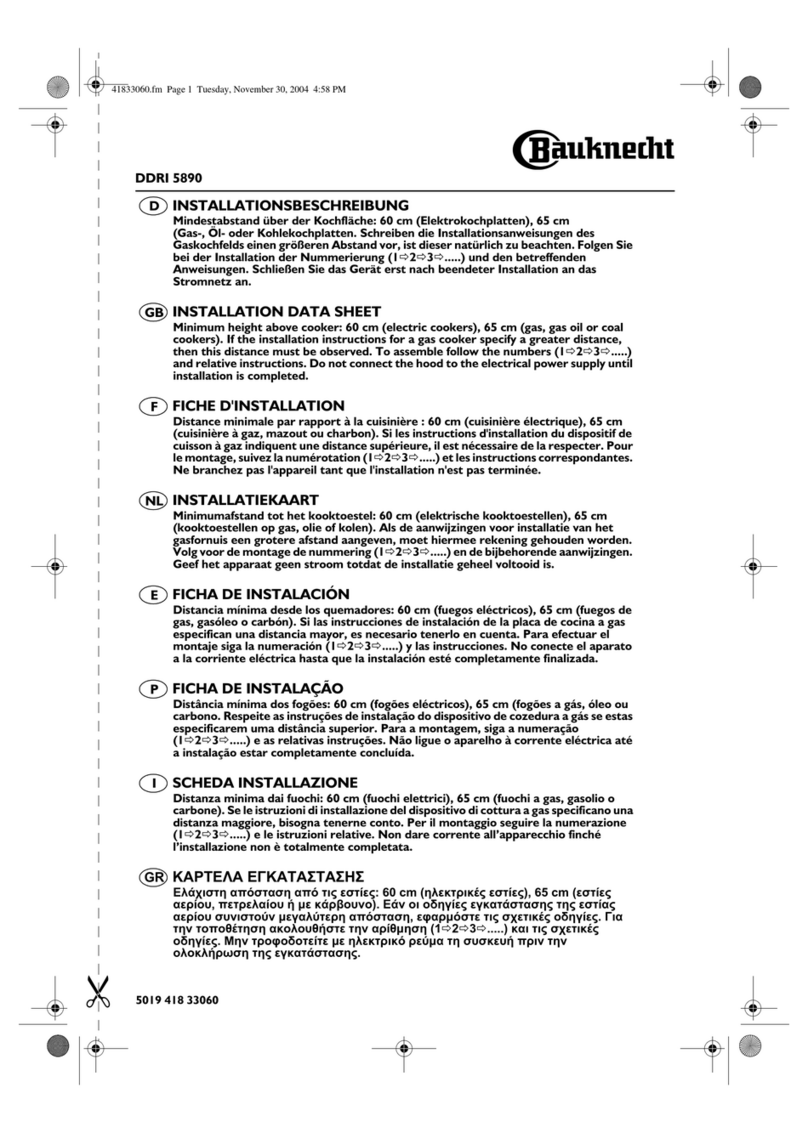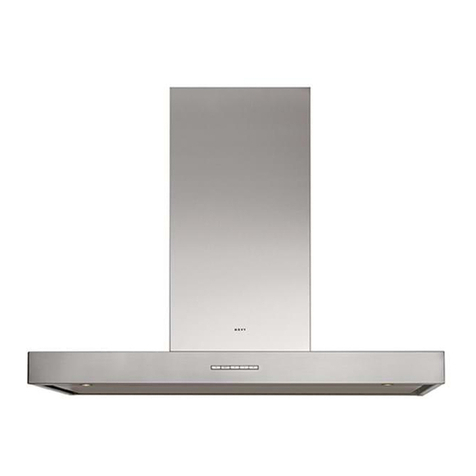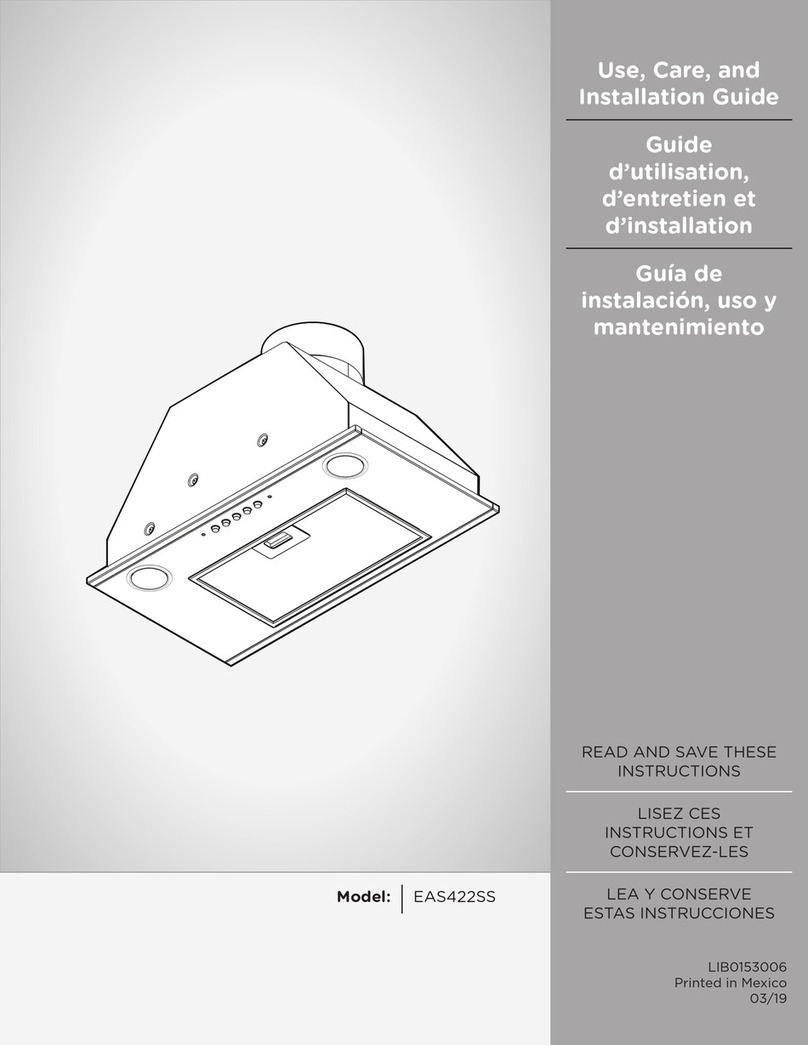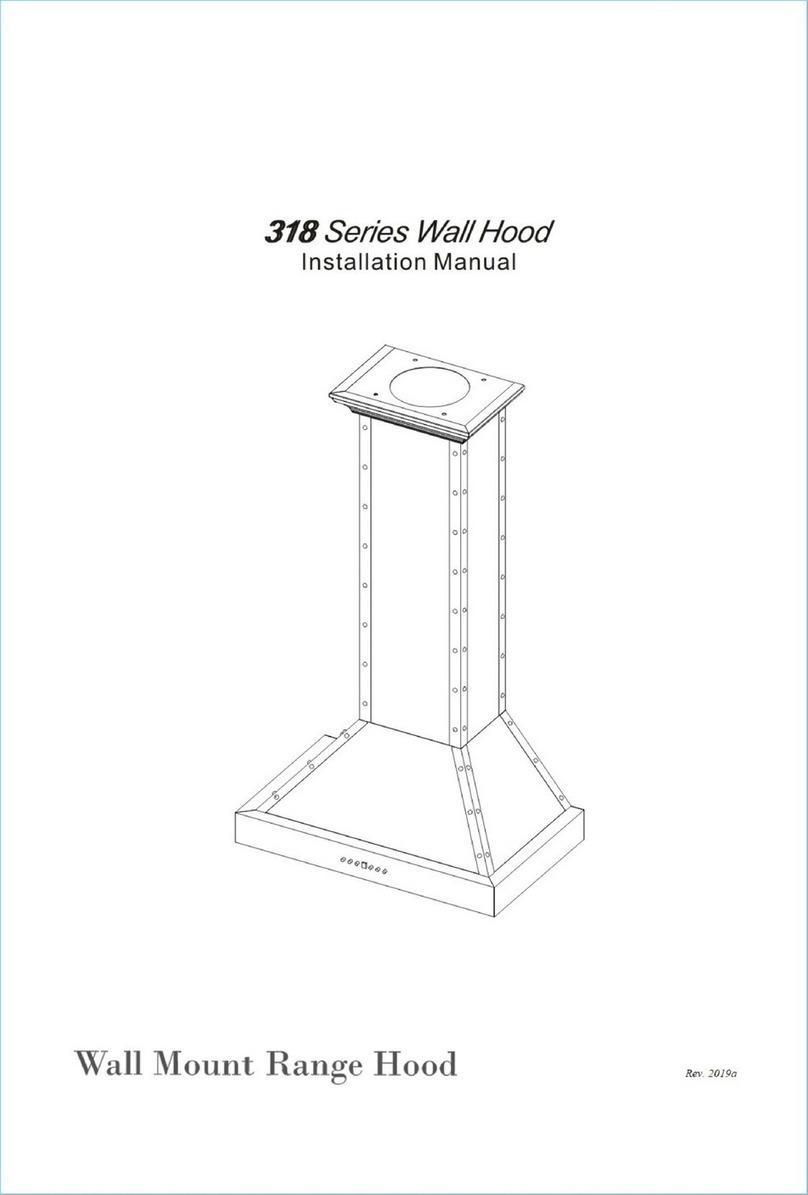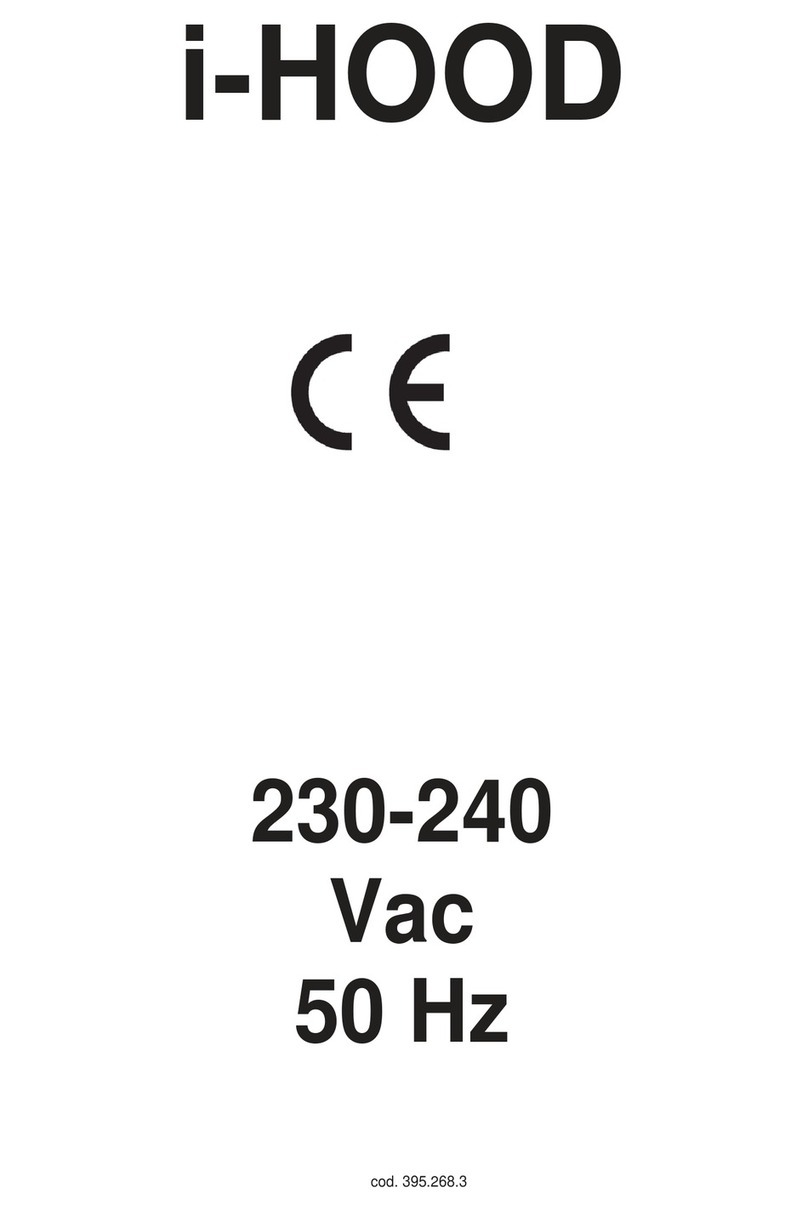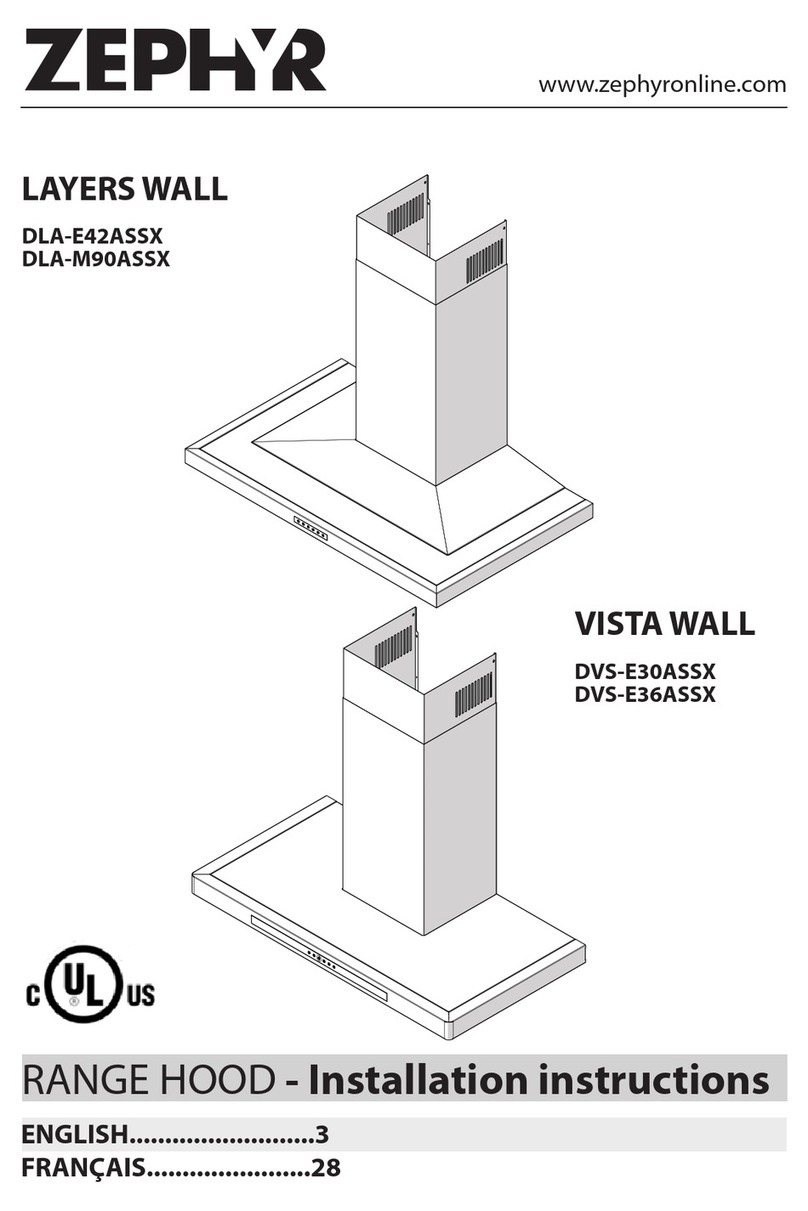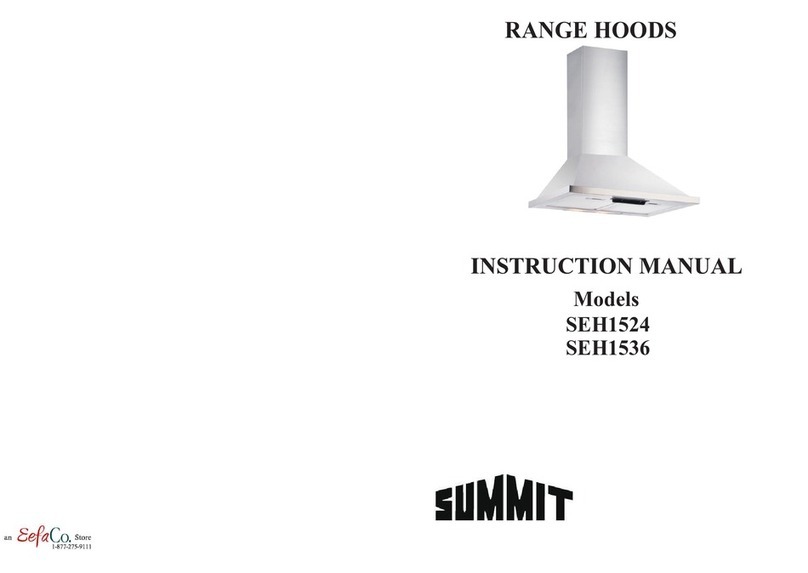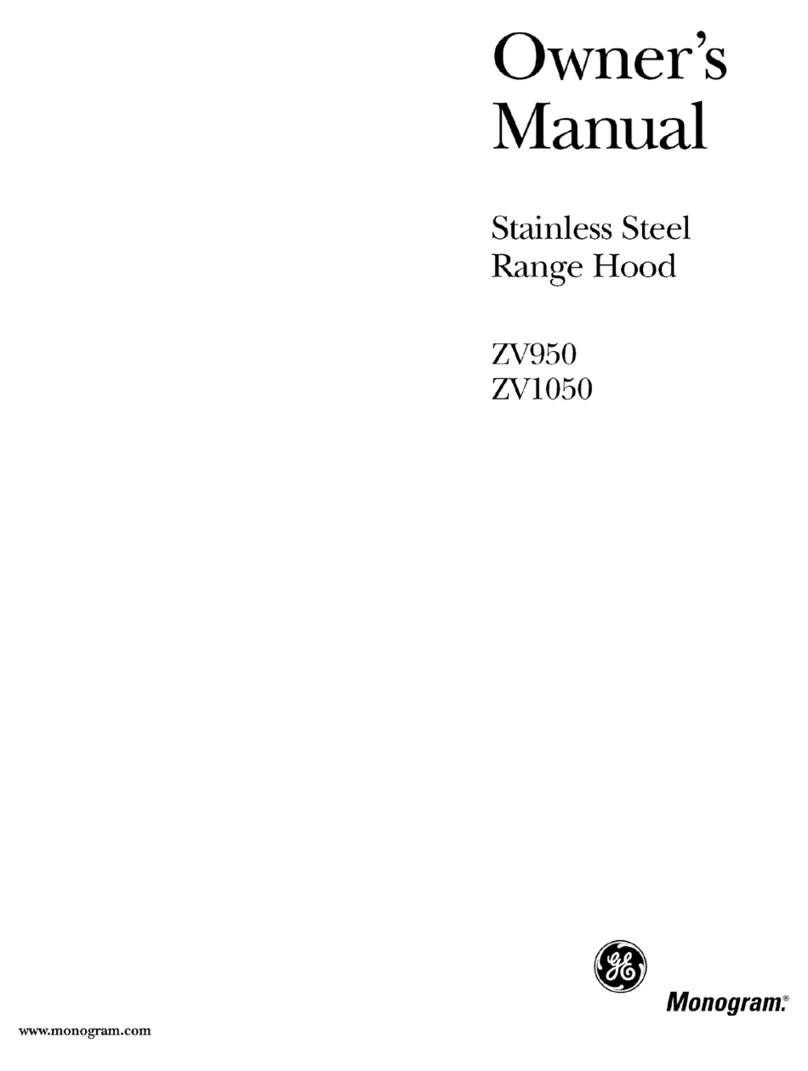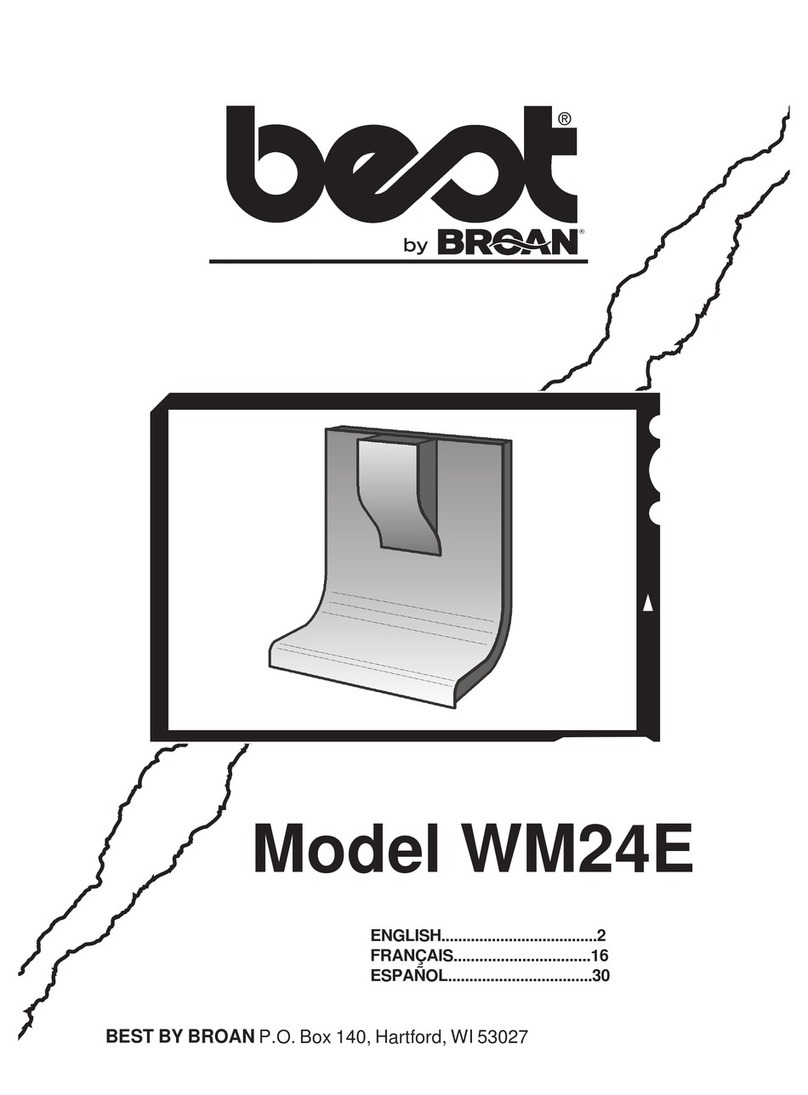Classique CLPP75L User manual

User Manual for your Classique
750mm Powerpack Rangehood
CLPP75L
NOTE: This user manual contains important information including safety &
installation points which will enable you to get the most out of your Classique
appliance. Please keep it in a safe place so that it is readily available for future
reference.

Contents
Environmental note 1
Important safety information 2
Specifications of your rangehood 5
Using your rangehood
Before first use 6
To use your rangehood 6
Cleaning your rangehood
The grease filter 7
Maintenance
Removing and cleaning the grease filter 8
Changing a light bulb 8
Fitting the carbon filter 9
Installation
Electrical connection 10
Before beginning installation 11
Installing your rangehood 12
Connecting to external ducting 13
Completing the installation 13
Packing List 14
Extraction mode or recirculation mode? 14
Troubleshooting 15

1
Environmental note
Note: Before discarding an old appliance, switch off and disconnect it from the
power supply. Cut off and render any plug useless. Cut the cable off directly
behind the appliance to prevent misuse. This should be undertaken by a
competent person.
This appliance is marked according to the European directive 2002/96/EC on Waste
electrical and Electronic Equipment (WEEE). By ensuring this product is disposed of
correctly, you will help prevent potential negative consequences for the environment
and human health, which could otherwise be caused by inappropriate waste handling of
this product.
The symbol on the product or on the documents accompanying the product
indicates that this appliance may not be treated as household waste. Instead it
shall be handed over to the applicable collection point for the recycling of electrical and
electronic equipment.
Disposal must be carried out in accordance with local environmental regulations for
waste disposal. For more detailed information about treatment, recovery and recycling
of this product, please contact your local city office or local waste management office.
oThe packaging materials that we use are environmentally friendly and can be
recycled.
oPlease discard all packaging material with due regard for the environment.

2
Important safety information
Your safety is of the utmost importance to us. Please make sure that
you read this instruction booklet before attempting to install or use
the appliance. If you are unsure of any of the information contained in
this booklet, please contact the Retailer where you purchased your
unit from.
IMPORTANT: Any installation work must be carried out by a
qualified electrician or competent person.
oThe rangehood must be installed in accordance with the installation instructions
and all measurements followed.
oIf the rangehood is installed for use above a gas appliance then the provision for
ventilation must be in accordance with the Gas Installations standard AS/NZS
5601.1 & 2:2013, the Gas Safety and Measurement Regulations 2010, and the
Building (Specified Systems, Change the Use, and Earthquake-prone Buildings)
Regulations 2005 issued under the Building Act 2004.
oIt is dangerous to alter the specifications or to modify this product. Do not tamper
with it or attempt to modify the appliance in any way.
oWhen installing the rangehood, ensure that the following recommended
distances are observed between the highest point on the hob top (including the
burners) and the bottom of the rangehood:
Electric cookers: 700 mm
Gas cookers: 700 mm
Coal/ oil cookers: 800 mm
IMPORTANT: Do not set your rangehood less than 700mm above your
cooker.

3
oWhen installed between adjoining wall cabinets, the cabinets must not overhang
the hob.
oThe edges of the rangehood are sharp –be mindful of this as you handle your
appliance, especially during installation and cleaning. DO NOT CLEAN IN
BEHIND THE GREASE FILTERS!
oIf the room where the rangehood is to be used contains a fuel burning appliance
such as a central heating boiler then its flue must be of the sealed or balanced
flue type.
oIf other types of flue or appliances are fitted, ensure that there is an adequate
supply of air in the room.
oWhen the rangehood is being used in its extractor function, ensure that the
ducting is fire retardant and that there are no bends sharper than 90 degrees as
this will reduce the efficiency of the rangehood.
oEnsure the ducting for the extractor function has the same diameter as the outlet
hole all the way through.
oKeep young children from using, playing with or tampering with the rangehood.
oYour rangehood is for domestic use only.
oPlease dispose of the packing material carefully –children are especially
vulnerable to it.
oDirty oil is an even greater fire risk.
oAlways put lids on pots and pans when cooking on a gas cooker.
oThe manufacturer refuses to accept any responsibility for damages arising to the
rangehood, including it catching on fire, due to a failure to observe the fire safety
advice contained in this instruction booklet.
oRemember that when in extraction mode, your rangehood is removing air from
your room. Ensure that proper ventilation measures are being observed.
oNote that the rangehood removes odours from your room, not steam.
oWarning - Always ensure that the rangehood has been switched off before
carrying out any work, including replacing light bulbs.

4
oDo not connect the ducting system of this appliance to any existing ventilation
system which is being used for any other purpose.
oDo not install above a cooker with a high level grill.
oNever leave frying pans unattended during use as overheated fats and oils might
catch fire.
oThe rangehood should not be exposed to a direct heat source from the cooking
device underneath it, i.e. a naked flame from a gas burner or heat from electric
hob zones without a pan on them.
oDo not attempt to use the rangehood if it is damaged in any way. Never attempt
to use it without the grease filters fitted or if the filters are excessively greasy!
oNever flambé cook under this rangehood.
oThe lights on this appliance should only be used during operation of the
rangehood. They should not be left on permanently and used as a lighting
source.
THE MANUFACTURER DECLINES ALL RESPONSIBILITY IN THE
EVENT OF FAILURE TO OBSERVE THE INSTRUCTIONS GIVEN
HERE FOR INSTALLATION, MAINTENANCE AND SUITABLE USE
OF THE RANGEHOOD.

5
Specifications of your rangehood
Product dimensions
Height: 254mm
Width: 750mm
Depth: 296mm
Your rangehood is fitted with:
oModern LED lighting (2 lamps)
oEasy-reach slider controls
oA 3 speed fan
oBrushed stainless steel finish
oAluminium filter
o60dB noise level
o150mm diameter ducting outlet
Extraction capacity: 700m³/hr
Optional extras: Recirculation possible with optional charcoal filter (ST1)

6
Using your rangehood
Before first use
IMPORTANT: This process must be followed before the rangehood is used for the
first time.
You should use a mild liquid detergent and a damp cloth on all the external areas of
your rangehood before it is used for the first time. This will help to remove any residues
from the manufacturing process.
To use your rangehood
oMake sure that it has been installed by a suitably qualified
person, as per the information contained in the manufacturer’s
installation instructions.
oFind the control panel, which is located at the front right of the
canopy.
oThere are two sliders on the control panel, which perform separate
functions.
1) Light control. The light can be used even when the motor is OFF.
0 = Light OFF
1 = Light ON
2) Motor speed control.
= Low speed
=Medium speed
= High speed
IMPORTANT: Ideally you should switch on your rangehood ten minutes before
you start to cook, or at the very least when you begin cooking. You should also
run your rangehood for ten minutes after you have finished cooking.

7
Cleaning your rangehood
IMPORTANT: Before cleaning, always ensure that you have
switched your rangehood off at the omni-polar switch, set at the
wall from the cable.
Cleaning
oClean the external parts of your rangehood with mild liquid detergent and a new
damp cloth.
oNever use abrasive powder, corrosive solvents or brushes.
oNever insert pointed objects into the motor’s protective grid.
oOnly clean the control panel and grease filter grill with mild liquid detergents and
a new damp cloth.
oIf you are using the appliance in recirculation mode, then be sure to replace the
carbon filters at the recommended interval (see section on “Fitting the carbon
filter” on page 9). A build up of grease could cause a fire hazard.
oNever attempt to clean the area above the grease filter.
The Grease filter
oYour rangehood includes a grease filter which helps to absorb grease particles to
protect your kitchen and furniture from greasy residues.
oYour rangehood includes a metal filter which can be periodically washed.
oThe filter may become flammable if it becomes saturated with greasy residue.
oTo prevent this fire hazard, the metal filter should be cleaned regularly.
Depending on use, this should be done every two months, using hot water and
normal washing-up detergent.
IMPORTANT: Do not wash the grease filter in a dishwasher as the chemicals can
cause damage.

8
Maintenance
Removing and cleaning the grease filter
oFirst remove the grease filter by sliding the securing nibs at the sides of the grille
on the underside of the cooker hood.
oSoak the grease filter in hot water and washing up liquid for about an hour.
oRinse it off thoroughly with hot water.
oRepeat the process if required.
oIMPORTANT: Let the grease filter dry thoroughly before refitting it in the
rangehood.
oNever attempt to use your rangehood without the grease filter in place.
Changing a light bulb (Part number: SYKL25 –LED LIGHT)
oIMPORTANT –Always ensure the rangehood has been
switched off before carrying out any work, including
replacing light bulbs.
oPrior to removing the LED light, ensure that it has
cooled down.
oPress gently on the underside of the bulb that needs to be replaced and twist
anticlockwise to release.
oReplace in reverse order using only genuine spare part SYKL25.
oIMPORTANT: Defective bulbs should be replaced immediately.
oIf the light still does not work, make sure that the internal plug is fitted properly
before you call for technical assistance.

9
Fitting the carbon filter (Part number ST1)
If the appliance is going to be used in recirculation mode then it is necessary to fit a
carbon filter. This will help to absorb unpleasant odours caused by cooking.
IMPORTANT: Before attempting to fit or remove the carbon filters,
you must ensure the rangehood is switched off first.
1) Press the handle of the metal grease filter towards the rear
part of the unit until it is released from the front housing, and
remove it by pressing downwards (Fig. 2 - above).
2) Remove the old carbon filters by twisting them anticlockwise
until they unlatch from the sides of the motor.
3) Place the new carbon filters (which have two fixing
tongues), turning clockwise so that the tongues latch onto
the motor’s sides.
4) Reposition the metal grease filters.

10
Installation
IMPORTANT: Before installation read all the instructions and make
sure that the voltage (V) and the frequency (Hz) indicated on the
rating plate are exactly the same as the voltage and frequency in
your home. The rating plate can be found behind the grease filters.
The manufacturer declines all responsibility in the event of the
installer failing to observe all the accident prevention regulations in
force, which are necessary for normal use and the regular operation of the electric
system.
Electrical connection
Your rangehood is intended for fitting with power cord & plug for connection to
10A power outlet.
o The power cable must be connected to
the terminals marked L (live) and N
(neutral) in the rangehood and fixed with
a cable clamp.
o The rangehood’s power cable must be
fitted upstream from the electrical
connection using an omni-polar switch
with a contact distance of at least 3mm.
WARNING –THIS APPLIANCE MUST BE EARTHED!
We recommend that the appliance is connected by a qualified electrician, who is
registered with the EWRB and who will comply with ALL regulations. The wires in the
mains lead are coloured in accordance with the following UK code:
Blue = Neutral, Brown = Live, Green/Yellow = Ground
If you can only find two wires in the cable (blue and brown), neither must be
connected to the Earth terminal!
oAs the colours of the wires in the appliance’s mains lead may not correspond
with the coloured markings identifying the terminals in your spur box, please
proceed as follows:
oThe blue wire must be connected to the terminal
marked “N” (neutral), or coloured black.
oThe brown wire must be connected to the terminal
marked “L” (live), or coloured red.
oThe green/yellow wire must be connected to the

11
terminal marked “E” or ⏚
Before beginning installation
oCheck that the product purchased is of a suitable size for the chosen installation
area. In addition, check whether there is an electrical socket available that will be
accessible once the rangehood is mounted. If the product is going to be used in
extraction mode, then there should also be space to connect a ducting hose to
the outside.
oCarry out all necessary masonry work prior to the fitting of the rangehood.
oEnsure that all electrical connections are carried out by a suitably qualified
person.
oBefore commencing installation of the rangehood the grease filters should be
removed.
oCheck inside the product and ensure that there is no transit packaging or any
other materials, such as packets of screws, guarantees etc. These should be
removed and kept for future use.
oIf possible, disconnect and move freestanding or slot-in cookers from their
position, to provide easier access to the rear wall and ceiling. If this is not
possible then a thick, protective covering should be placed over the worktop, hob
top or cooker. This will help to protect these surfaces from damage and debris.
oSelect a flat surface for assembling the rangehood. Cover that surface with a
protective covering and place all rangehood parts and fittings on it.
oDo not tile, grout or silicone this appliance to the wall or cabinetry. This appliance
is designed to be surface mounted only.

12
Installing your rangehood
IMPORTANT: You will have to decide before installing your rangehood whether to use it
in extraction mode or recirculation mode. Please refer to page 14 to understand the
differences between these two modes.
oWe recommend that at least two people install this rangehood.
oIf you are using the appliance in recirculation mode, then PLEASE NOTE that all
of the vent in the upper chimney section must be exposed. You will have to take
this into account when calculating the minimum height of the extractor when
installed.
oIMPORTANT: If the recirculation vents are obstructed then the efficiency of
the extraction will be affected and could damage the motor.
IMPORTANT: YOUR RANGEHOOD SHOULD BE CONNECTED TO YOUR MAINS
SUPPLY AFTER THE REST OF THE INSTALLATION PROCESS HAS BEEN
COMPLETED.
1) The cooker hood should be placed at a distance of 65-75cm (26-30inch) from the
cooking surface for the best effect.
2) Drill a hole in the cupboard, 715mm*265mm. Make sure the distance between
the edge of the hole and the edge of the cupboard edge is at least 35mm.
3) Take down the filter and remove the four screws on the panel.
4) Use eight ST4 x 18mm screws to fix the hood into cabinet.
5) Fix the panel back to the body and equip the filter.
6) Connect the ducting pipe to the outlet.

13
Connecting to external ducting (top)
oConnect the coupling to the top of the rangehood, using two of the smaller
screws provided.
o(If side ducting, this is either through the wall or the Soffit)
oConnect a 150 mm ducting hose to a discharge outlet that is suitable for cooking
vapours. Please note that the ducting hose is not supplied with the appliance but
one can be obtained from the Retail outlet where you purchased your appliance.
oThe maximum distance between the coupling and your discharge outlet should
be 3 metres, with one 90 degree bend. For each additional 90 degree bend, the
maximum distance is reduced by a further metre.
oBefore fixing the rangehood into the kitchen unit, you should connect the other
end of the ducting hose to the coupling in the top of the cooker hood.
Completing the installation
If you are setting the appliance to recirculation mode, then you should now fit the two
carbon filters. See the section “Fitting the carbon filter” on page 9.
The electrical connection must correspond to the electrical requirement noted on the
rating plate, which is placed inside the rangehood. The appliance should now be
connected to the electrical supply. See page 10 for detailed information on the electrical
connection.
Refit the grease filter and then switch on the mains supply to the appliance. Check that
the appliance is operating correctly by selecting each speed and switching the light bulb
on and off.

14
Packing list
Opening the box, you will find the following items :
Description
Illustration
QTY
Cooker hood
1
Screw
(ST4 x 18mm)
8
Extraction mode or recirculation mode?
IMPORTANT: You will have to decide prior to installing your rangehood whether to use
it in extraction mode or recirculation mode.
What is the difference between extraction and recirculation modes?
In extraction mode, the stale air will be taken via the grease filter and out of the room via
external ducting.
In recirculation mode stale air is taken via the grease filter, and passed through a
charcoal filter for purification. The air then re-enters the kitchen via an opening in the
rangehood.
For optimum performance, we recommend that the rangehood is used in extraction
mode and connected to external ducting.
Unfortunately if you live in a flat, or if the rangehood is too far from an outside wall, this
may not be possible. The only alternative is to recirculate the air.
Do I need a charcoal filter?
All rangehoods have a grease filter but if you are using your rangehood in recirculation
mode, then a charcoal filter must be fitted in addition to the grease filter.

15
Troubleshooting
IMPORTANT: If your rangehood appears not to be operating properly, before
contacting an authorised service agent, please refer to the checklist below.
My rangehood will not start.
oCheck that the rangehood is connected to the power supply and
whether you have selected any of the fan speeds.
My rangehood is not working effectively.
oCheck that the fan speed is set to an appropriate setting.
oCheck that the grease filters are not dirty and do not require cleaning.
oIf the rangehood is set up for recirculation mode, check that the carbon filter does
not need to be replaced.
oIf the rangehood is set up for extraction mode, check that the ducting hose and
discharge outlet are not blocked.
My rangehood is noisy and/or vibrating.
oCheck whether the installation has been completed as per the instruction booklet.
oIt is normal to get a certain amount of noise and vibration, due to the extraction
capacity of the rangehood.
Where do I go to get parts for my rangehood.
oIf you need bulbs, filters, or semi-rigid aluminium ducting for your rangehood,
please contact the retailer from where you purchased it, or visit
www.classique.co.nz/service for more information.
o

16
My rangehood is not working properly.
Do not attempt to repair the appliance yourself. If the appliance is not operating
correctly please contact an authorised service agent. Go to www.classique.co.nz
or phone 0800 M10 HLP / 0800 610 457 to locate your closest service agent.
DO NOT ATTEMPT TO REPAIR THE APPLIANCE YOURSELF.
Please note that if a Technician is asked to attend whilst the product is
under guarantee and finds that the problem is not the result of an
appliance fault, then you may be liable for the cost of the call-out
charge.
The appliance must be accessible for the Technician to perform any
necessary repair. If your appliance is installed in such a way that an
engineer is concerned that damage will be caused to the appliance or your kitchen, then
the Technician will not complete a repair.
This includes situations where appliances have been tiled in, sealed in with sealant,
have wooden obstructions placed in front of the appliance such as plinths, or where any
installation other than the one specified by the manufacturer has been completed.
Please refer to the conditions of guarantee that appear on the warranty card that you
receive with the appliance.
IMPORTANT: The manufacturer operates a policy of continuous improvement and
reserves the right to adjust and modify its products without prior notification.


Imported by Applico Ltd.
Private Bag 92900
Onehunga, Auckland 1061,
New Zealand
Website
www.classique.co.nz
Phone
0800 M10 HLP
or
0800 610 457
Table of contents
Other Classique Ventilation Hood manuals
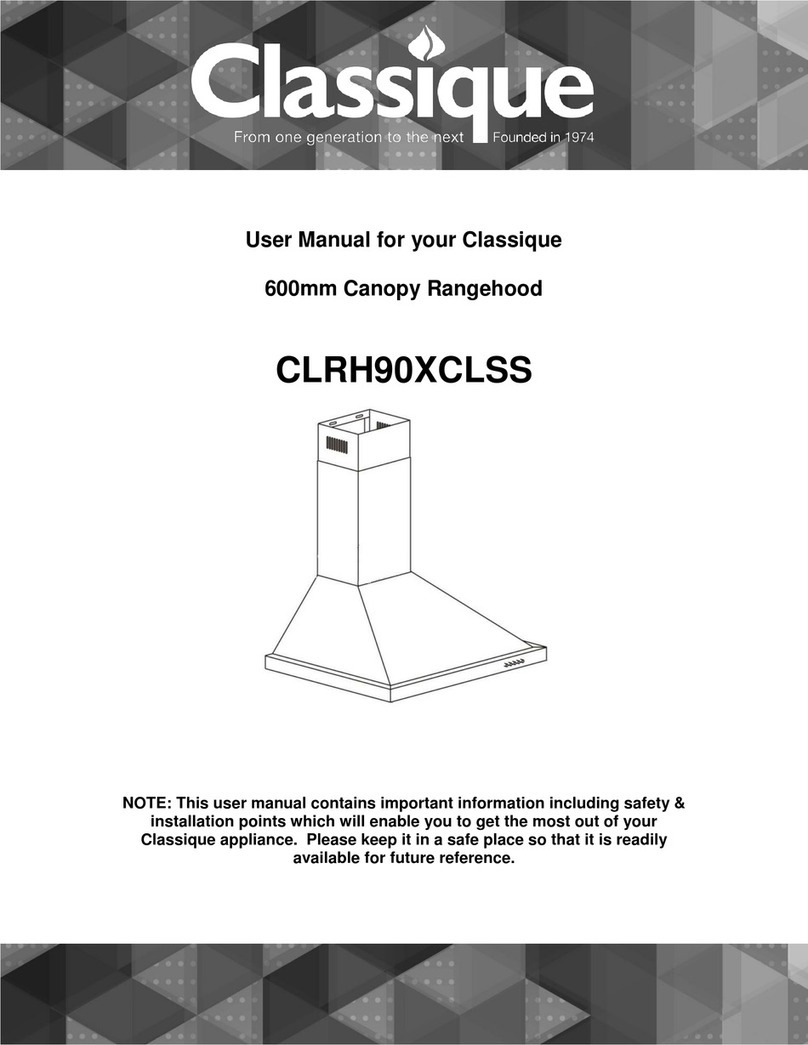
Classique
Classique CLRH90XCLSS Instruction Manual
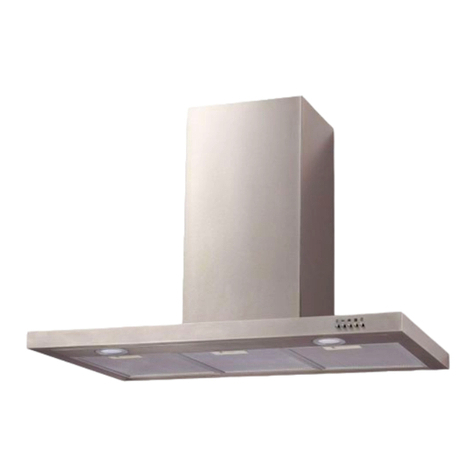
Classique
Classique CLRH60BLSS User manual
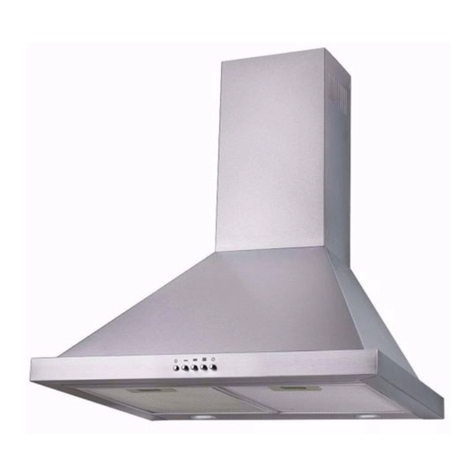
Classique
Classique CLRH60LSS User manual
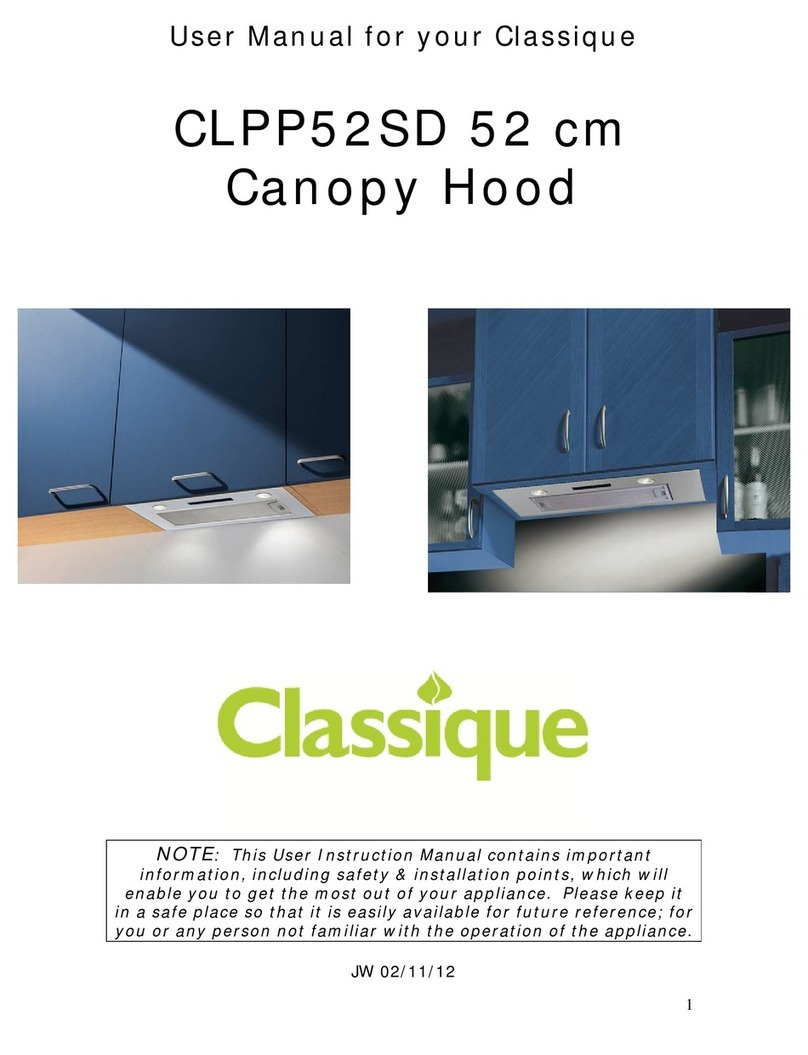
Classique
Classique CLPP52SD User manual
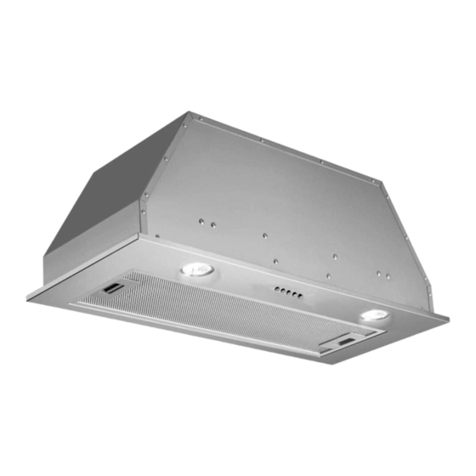
Classique
Classique CLPP52L User manual
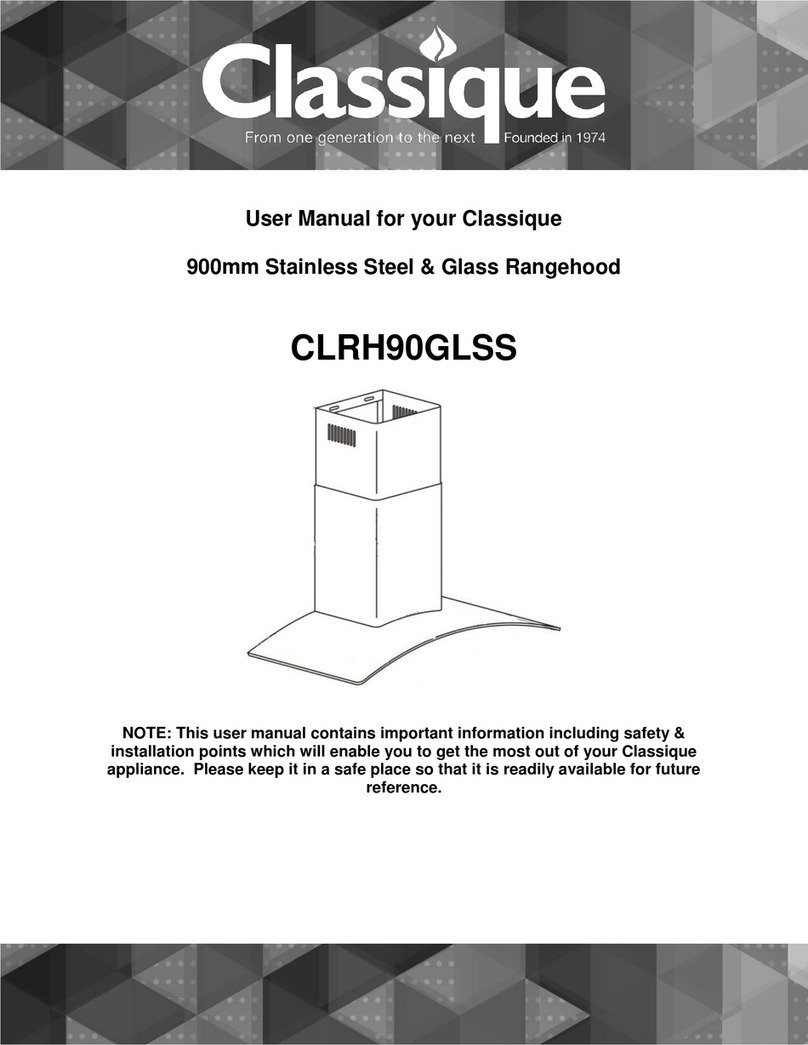
Classique
Classique CLRH90GLSS User manual
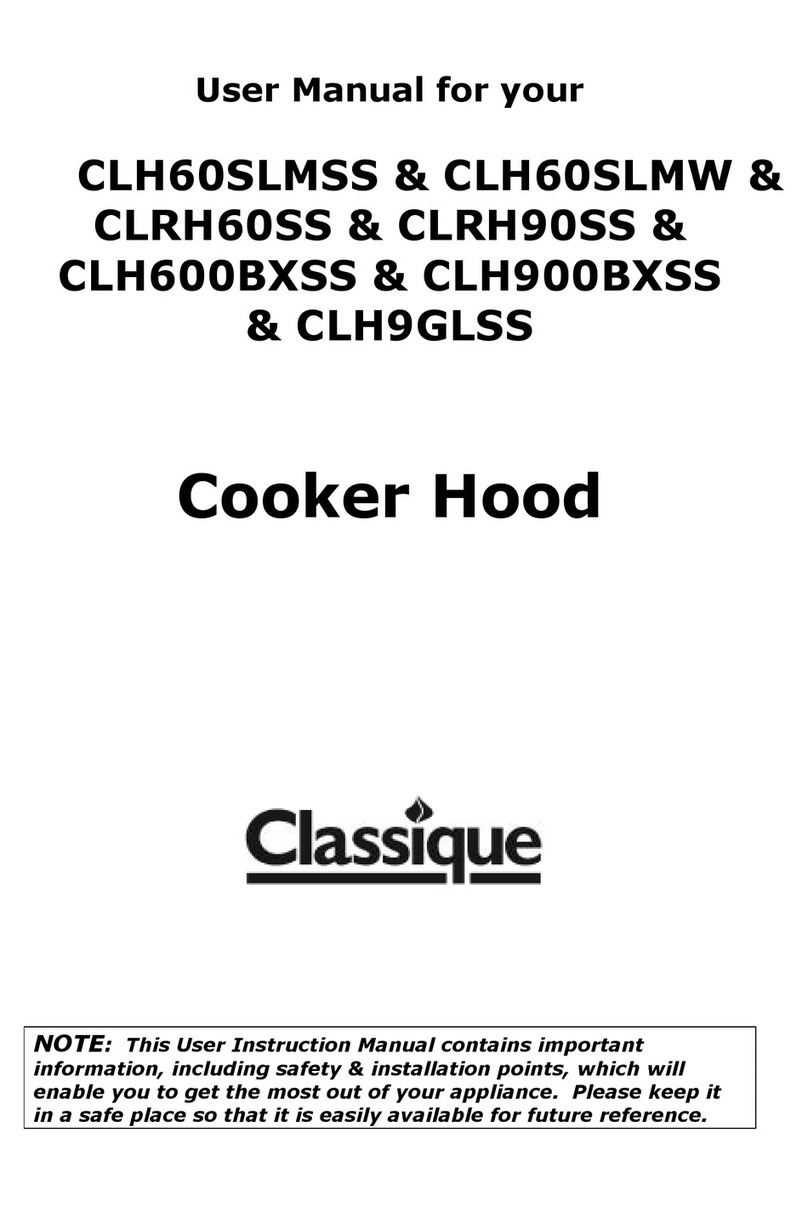
Classique
Classique CLH60SLMSS User manual
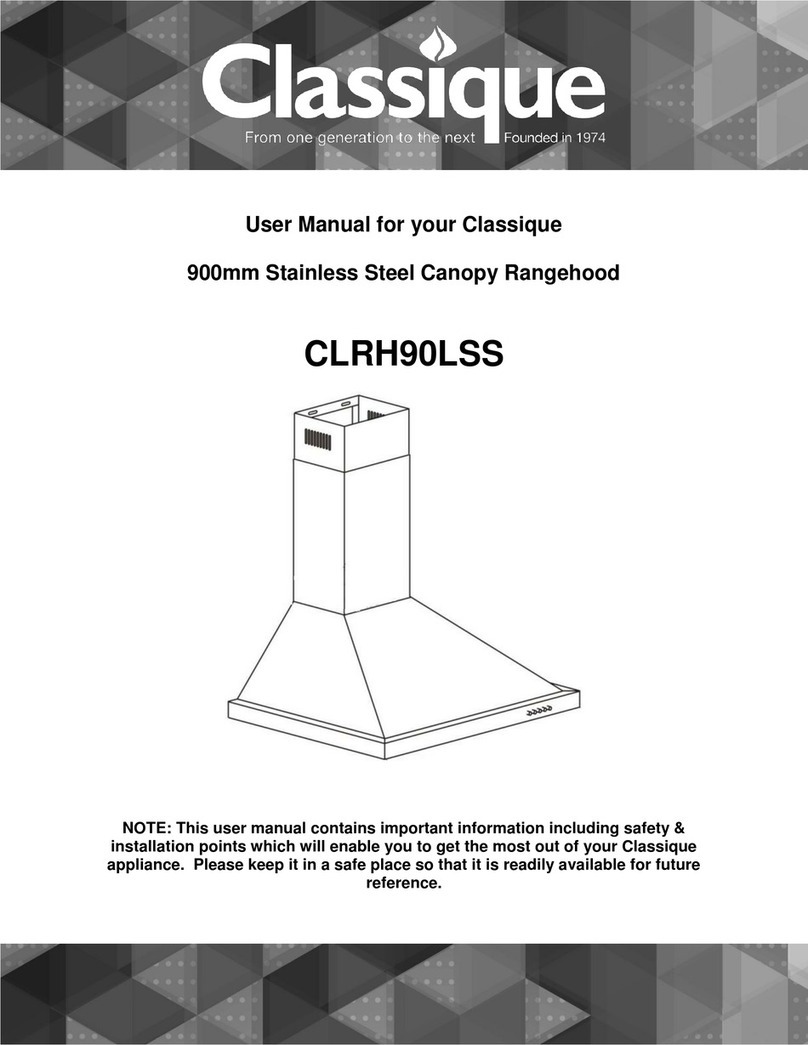
Classique
Classique CLRH90LSS User manual
